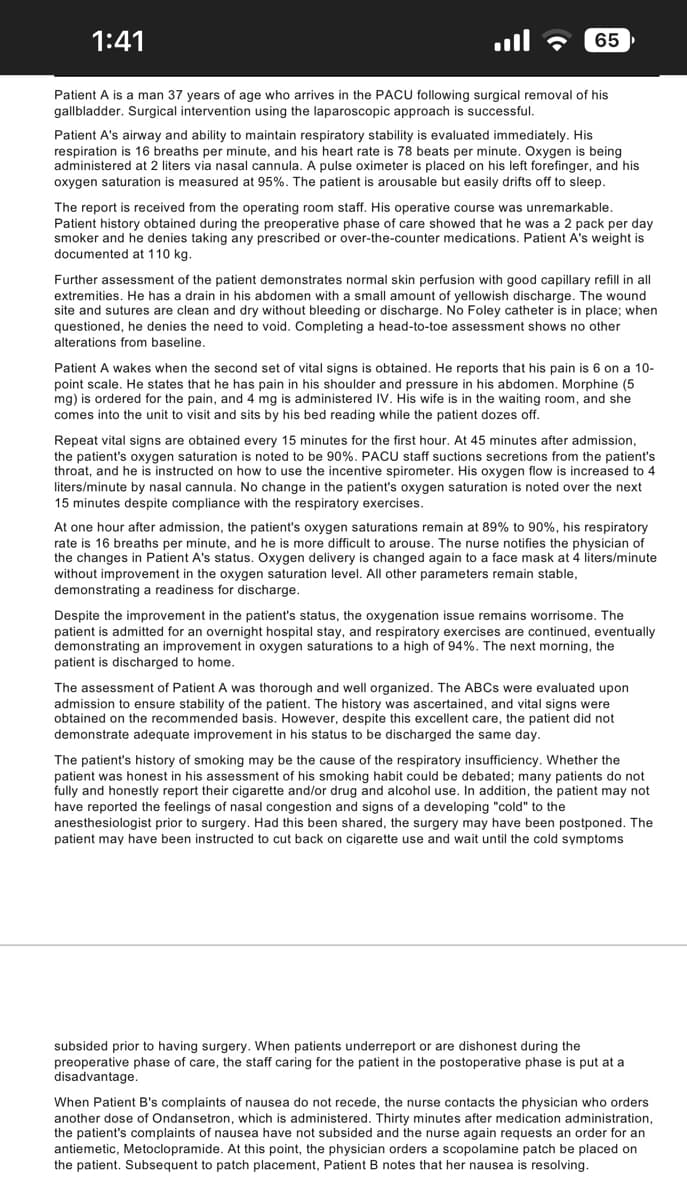Chapter11: The Respiratory System
Section: Chapter Questions
Problem E1CRE
Related questions
Question
Identify nursing care that should made by the Surgery Ward Nurse in the preparation for the
surgical operation?

Transcribed Image Text:1:41
Patient A is a man 37 years of age who arrives in the PACU following surgical removal of his
gallbladder. Surgical intervention using the laparoscopic approach is successful.
65
Patient A's airway and ability to maintain respiratory stability is evaluated immediately. His
respiration is 16 breaths per minute, and his heart rate is 78 beats per minute. Oxygen is being
administered at 2 liters via nasal cannula. A pulse oximeter is placed on his left forefinger, and his
oxygen saturation is measured at 95%. The patient is arousable but easily drifts off to sleep.
The report is received from the operating room staff. His operative course was unremarkable.
Patient history obtained during the preoperative phase of care showed that he was a 2 pack per day
smoker and he denies taking any prescribed or over-the-counter medications. Patient A's weight is
documented at 110 kg.
Further assessment of the patient demonstrates normal skin perfusion with good capillary refill in all
extremities. He has a drain in his abdomen with a small amount of yellowish discharge. The wound
site and sutures are clean and dry without bleeding or discharge. No Foley catheter is in place; when
questioned, he denies the need to void. Completing a head-to-toe assessment shows no other
alterations from baseline.
Patient wakes when the second set of vital signs is obtained. He reports that his pain is 6 on a 10-
point scale. He states that he has pain in his shoulder and pressure in his abdomen. Morphine (5
mg) is ordered for the pain, and 4 mg is administered IV. His wife is in the waiting room, and she
comes into the unit to visit and sits by his bed reading while the patient dozes off.
Repeat vital signs are obtained every 15 minutes for the first hour. At 45 minutes after admission,
the patient's oxygen saturation is noted to be 90%. PACU staff suctions secretions from the patient's
throat, and he is instructed on how to use the incentive spirometer. His oxygen flow is increased to 4
liters/minute by nasal cannula. No change in the patient's oxygen saturation is noted over the next
15 minutes despite compliance with the respiratory exercises.
At one hour after admission, the patient's oxygen saturations remain at 89% to 90%, his respiratory
rate is 16 breaths per minute, and he is more difficult to arouse. The nurse notifies the physician of
the changes in Patient A's status. Oxygen delivery is changed again to a face mask at 4 liters/minute
without improvement in the oxygen saturation level. All other parameters remain stable,
demonstrating a readiness for discharge.
Despite the improvement in the patient's status, the oxygenation issue remains worrisome. The
patient is admitted for an overnight hospital stay, and respiratory exercises are continued, eventually
demonstrating an improvement in oxygen saturations to a high of 94%. The next morning, the
patient is discharged to home.
The assessment of Patient A was thorough and well organized. The ABCs were evaluated upon
admission to ensure stability of the patient. The history was ascertained, and vital signs were
obtained on the recommended basis. However, despite this excellent care, the patient did not
demonstrate adequate improvement in his status to be discharged the same day.
The patient's history of smoking may be the cause of the respiratory insufficiency. Whether the
patient was honest in his assessment of his smoking habit could be debated; many patients do not
fully and honestly report their cigarette and/or drug and alcohol use. In addition, the patient may not
have reported the feelings of nasal congestion and signs of a developing "cold" to the
anesthesiologist prior to surgery. Had this been shared, the surgery may have been postponed. The
patient may have been instructed to cut back on cigarette use and wait until the cold symptoms
subsided prior to having surgery. When patients underreport or are dishonest during the
preoperative phase of care, the staff caring for the patient in the postoperative phase is put at a
disadvantage.
When Patient B's complaints of nausea do not recede, the nurse contacts the physician who orders
another dose of Ondansetron, which is administered. Thirty minutes after medication administration,
the patient's complaints of nausea have not subsided and the nurse again requests an order for an
antiemetic, Metoclopramide. At this point, the physician orders a scopolamine patch be placed on
the patient. Subsequent to patch placement, Patient B notes that her nausea is resolving.
Expert Solution
This question has been solved!
Explore an expertly crafted, step-by-step solution for a thorough understanding of key concepts.
Step by step
Solved in 2 steps

Recommended textbooks for you







Basic Clinical Lab Competencies for Respiratory C…
Nursing
ISBN:
9781285244662
Author:
White
Publisher:
Cengage

Essentials of Pharmacology for Health Professions
Nursing
ISBN:
9781305441620
Author:
WOODROW
Publisher:
Cengage

Surgical Tech For Surgical Tech Pos Care
Health & Nutrition
ISBN:
9781337648868
Author:
Association
Publisher:
Cengage